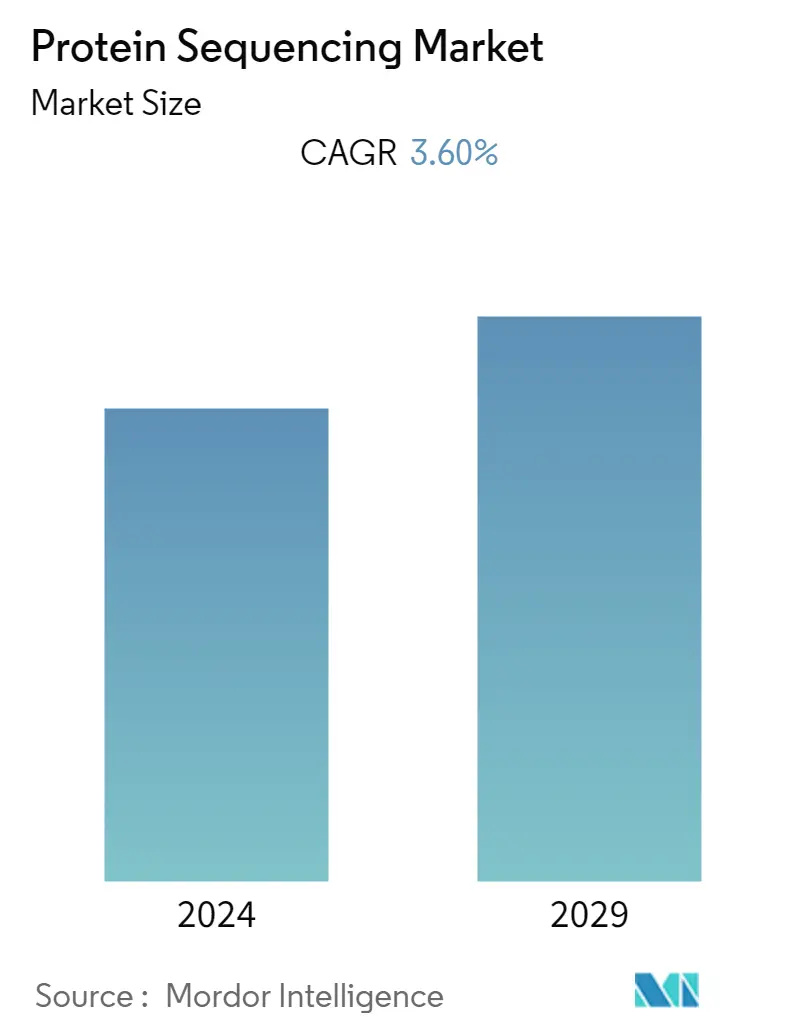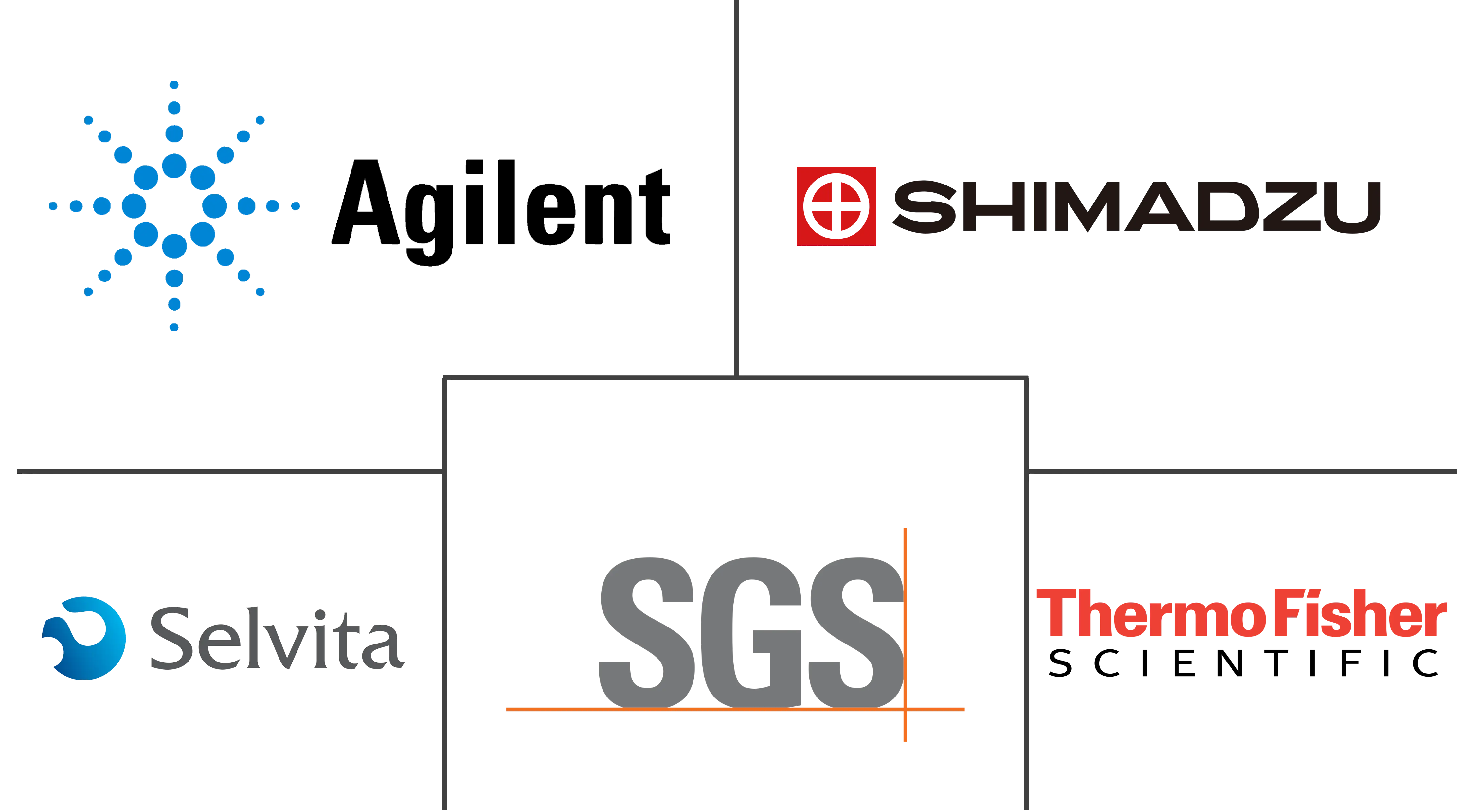Market Size of Protein Sequencing Industry

| Study Period | 2019 - 2029 |
| Base Year For Estimation | 2023 |
| Forecast Data Period | 2024 - 2029 |
| CAGR | 3.60 % |
| Fastest Growing Market | Europe |
| Largest Market | North America |
Major Players
*Disclaimer: Major Players sorted in no particular order |
Protein Sequencing Market Analysis
The protein sequencing market is expected to register a CAGR of 3.6% over the forecast period.
COVID-19 has had a significant impact on the market since the detection of COVID-19 was utilized by the advancements offered by protein sequencing. For instance, as per the article published in July 2022 in Frontiers, the growing number of protein sequences deposited in biological databases on a daily basis, as well as the N protein conservation among viral strains along with computational approaches, were used to identify possible novel targets for SARS-CoV-2 and SARS-CoV-related viruses. Hence, such protein sequencing techniques for identifying the COVID-19 targets significantly impacted the market growth over the forecast period. The market is anticipated to witness growth in the coming years due to the increase in the utilization of protein sequencing in biomedical research.
The major factors for the growth of the protein sequencing market include the rising focus on target-based drug development and technological advancements and increasing funding for proteomics research. For instance, as per the article published in June 2022 in ACS Publications, to selectively target a protein and to design small molecules, knowing the protein structure with all its specific conformation is critical. AlphaFold2, a deep neural network-based machine learning programme, was able to predict unknown protein structures with exceptional accuracy and which helped the drug design more efficiently. Similarly, as per the article published in September 2022 in TechRxiv, the researchers presented a method for identifying single amino acids (AAs) in bulk or with a few molecules from a single binary measurement. It can be used in conjunction with Edman degradation (or another approach) to sequence a peptide or identify the parent protein from a partial sequence. This binary/digital methodology is based on the super specificity property of transfer RNAs (tRNAs), and it differs significantly from the traditional and newer single molecule (SM) sequencing approaches that use analog measurements. Hence, such technological advancements in the field of protein sequencing are likely to fuel market growth over the forecast period.
Furthermore, the rising funding for proteomic research is expected to boost the protein sequencing market over the forecast period. For instance, in June 2021, with USD 6 million in Seed Funding, MIT Spinout Glyphic Biotechnologies planned to build a proteomic platform to tackle the proteomics and protein analysis market. Additionally, in May 2022, Proteomics International Laboratories was awarded approximately USD 286,833 in funding from the Australian Government under the Medical Research Future Fund (MRFF) initiative. The funding is expected to support manufacturing the PromarkerD test in Australia.
Thus, due to the rise in advantages offered by protein sequencing and the increase in research funding, the studied market is anticipated to witness growth in the market over the forecast period. However, the high cost of protein sequencing equipment is anticipated to restrain the market growth over the forecast period.
Protein Sequencing Industry Segmentation
As per the scope of this report, protein sequencing is the process of determining the amino acid sequence of all or part of a protein or peptide. These techniques are helpful in the identification of proteins and characterize their post-translational modifications. The Protein Sequencing Market is Segmented by Products and Services (Instruments (Mass Spectrometry, Edman Degradation), Reagents and Consumables Software and Services), Applications (Biomarker Discovery, Protein Engineering Studies, Biotherapeutics, and Others), End-User (Pharmaceutical & Biotechnology Companies, Research Centers, Others), Geography (North America, Europe, Asia-Pacific, Middle East and Africa, South America). The market report also covers the estimated market sizes and trends for 17 countries across major regions globally. The report offers the value (in USD million) for the above segments.
| By Products and Services | ||||
| ||||
| Reagents and Consumables | ||||
| Softwares and Services |
| By Application | |
| Biomarker Discovery | |
| Protein Engineering Studies | |
| Biotherapeutics | |
| Others |
| By End User | |
| Pharmaceutical and Biotechnology Companies | |
| Research Centers | |
| Others |
| Geography | ||||||||
| ||||||||
| ||||||||
| ||||||||
| ||||||||
|
Protein Sequencing Market Size Summary
The protein sequencing market is poised for growth, driven by advancements in technology and increased funding for proteomics research. The market has seen a significant impact from the COVID-19 pandemic, as protein sequencing techniques were crucial in identifying targets for the virus, thereby enhancing market expansion. The rising focus on target-based drug development and innovations such as AlphaFold2, which predicts protein structures with high accuracy, are key factors propelling the market forward. Despite the high cost of protein sequencing equipment posing a challenge, the benefits and advancements in the field are expected to sustain market growth over the forecast period.
North America is anticipated to hold a substantial share of the protein sequencing market, supported by technological advancements and robust healthcare infrastructure. The region benefits from significant research funding and strategic activities by key players, which are expected to drive market growth. Companies like Quantum-Si and Seer are making strides with new technologies that enhance proteomic research and drug discovery. The market's fragmented nature, with numerous players engaging in mergers, acquisitions, and collaborations, further contributes to its dynamic growth landscape.
Protein Sequencing Market Size - Table of Contents
-
1. MARKET DYNAMICS
-
1.1 Market Overview
-
1.2 Market Drivers
-
1.2.1 Rising Focus on Target based Drug Development
-
1.2.2 Increasing Funding for Proteomic Research
-
-
1.3 Market Restraints
-
1.3.1 High Cost of Protein Sequencing Equipment
-
-
1.4 Porter Five Forces
-
1.4.1 Threat of New Entrants
-
1.4.2 Bargaining Power of Buyers/Consumers
-
1.4.3 Bargaining Power of Suppliers
-
1.4.4 Threat of Substitute Products
-
1.4.5 Intensity of Competitive Rivalry
-
-
-
2. MARKET SEGMENTATION (Market Size by Value - USD Million)
-
2.1 By Products and Services
-
2.1.1 Instruments
-
2.1.1.1 Mass Spectrometry
-
2.1.1.2 Edman Degradation
-
-
2.1.2 Reagents and Consumables
-
2.1.3 Softwares and Services
-
-
2.2 By Application
-
2.2.1 Biomarker Discovery
-
2.2.2 Protein Engineering Studies
-
2.2.3 Biotherapeutics
-
2.2.4 Others
-
-
2.3 By End User
-
2.3.1 Pharmaceutical and Biotechnology Companies
-
2.3.2 Research Centers
-
2.3.3 Others
-
-
2.4 Geography
-
2.4.1 North America
-
2.4.1.1 United States
-
2.4.1.2 Canada
-
2.4.1.3 Mexico
-
-
2.4.2 Europe
-
2.4.2.1 Germany
-
2.4.2.2 United Kingdom
-
2.4.2.3 France
-
2.4.2.4 Italy
-
2.4.2.5 Spain
-
2.4.2.6 Rest of Europe
-
-
2.4.3 Asia Pacific
-
2.4.3.1 China
-
2.4.3.2 Japan
-
2.4.3.3 India
-
2.4.3.4 Australia
-
2.4.3.5 South Korea
-
2.4.3.6 Rest of Asia-Pacific
-
-
2.4.4 Middle East and Africa
-
2.4.4.1 GCC
-
2.4.4.2 South Africa
-
2.4.4.3 Rest of Middle East and Africa
-
-
2.4.5 South America
-
2.4.5.1 Brazil
-
2.4.5.2 Argentina
-
2.4.5.3 Rest of South America
-
-
-
Protein Sequencing Market Size FAQs
What is the current Protein Sequencing Market size?
The Protein Sequencing Market is projected to register a CAGR of 3.60% during the forecast period (2024-2029)
Who are the key players in Protein Sequencing Market?
Agilent Technologies, Inc., SGS SA, Shimadzu Corporation, Thermo Fisher Scientific Inc. and Selvita SA are the major companies operating in the Protein Sequencing Market.

